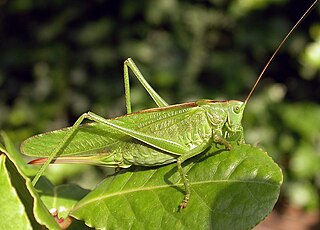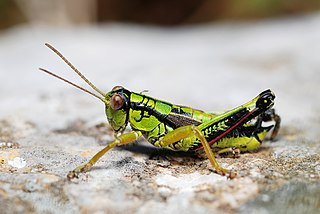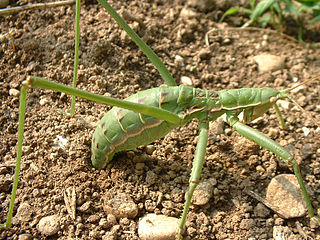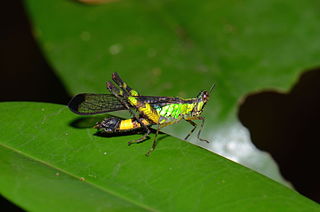
Cooloola is a genus of ensiferan orthopterans known as Cooloola monsters. It is the only genus in the subfamily Cooloolinae and family Cooloolidae of the superfamily Stenopelmatoidea.

The Tettigoniinae are a subfamily of bush crickets or katydids, which contains hundreds of species in about twelve tribes.

Hemiandrus is a genus of wētā in the family Anostostomatidae. In New Zealand they are known as ground wētā due to their burrowing lifestyle. Hemiandrus wētā are nocturnal, and reside in these burrows during the day. Ground wētā seal the entrance of their burrow during the day with a soil plug or door so that their burrow is concealed. This genus was originally said to be distributed in Australia and New Zealand, however, with recent molecular genetic methods, this is under debate. Ground wētā adults are smaller than other types of wētā, with the unusual trait of having both long and short ovipositors, depending on the species. The name of this genus is said to come from this trait as hemi- mean half and -andrus means male, as the species where the female has a short ovipositor can sometimes be mistaken for a male. This genus has a diverse diet, depending on the species.
Bienkotetrix is a genus of groundhoppers in the family Tetrigidae comprising, as of December 2018, only a single species, Bienkotetrix tibetanus. As its name suggests, it occurs in Tibet.

Metrioptera is a genus of insects in the tribe Platycleidini and subfamily Tettigoniinae, include the bog and meadow bush crickets. They are found in Eurasia.

Miramella is a small genus of short-horned grasshoppers in the subfamily Melanoplinae. They are found in Europe and eastern Asia. As of January 2019, Orthoptera Species File lists seven species in three subgenera. The genus was first named in 1932. Miramella is the type genus of the subtribe Miramellina.
Kansua is a small genus of bush crickets or katydids in the tribe Drymadusini. Species are found in northern China.

Meconema is the type genus of European bush crickets in the subfamily Meconematinae, tribe Meconematini and subtribe Meconematina.

Tympanophora is a genus of bush-crickets, known as balloon-winged katydids, found in Australia. It is the only extant (living) genus in the subfamily Tympanophorinae.

Saga is a genus of bush crickets or katydids containing around 15 species as of 2018. It is the only genus in the tribe Sagini and belongs to the subfamily Saginae. Species have been recorded from southern Europe and western and central Asia.

The Tanaoceridae are an insect family in the monotypic superfamily Tanaoceroidea in the suborder Caelifera. They are sometimes called desert long-horned grasshoppers.

Patanga is a genus of grasshoppers in the subfamily Cyrtacanthacridinae. Species are distributed throughout Asia: from India, China, Japan, Indochina and western Malesia. The genus was named by Boris Uvarov in 1923, with the type species the economically significant Bombay locust: which has also been placed in genus Nomadacris.

Erianthus is a genus of grasshoppers restricted to Southeast Asia. They occur in Japan, northeast India, Myanmar, Thailand, Vietnam, South China including Hong Kong, and extend east to Sumatra. In the past some neotropical species were also included in the genus. They have narrow ranges and species are identifiable only by their characteristics of male and female genitalia.

Erucius is a genus of "monkey grasshoppers" in the family Chorotypidae. Species in this genus can be found in Vietnam and Malesia, including the Philippines. It is the only genus in the subfamily Eruciinae.
Oxyphlaeobella is a genus of grasshoppers in the family Acrididae, subfamily Acridinae. Species can be found in southern China and Indo-China.

The Gryllotalpoidea are a superfamily of insects that includes the mole crickets and the ant crickets. The type genus is Gryllotalpa.

Dolichopoda is a genus of cave crickets in the tribe Dolichopodaini, subfamily Dolichopodainae. They are distributed in the Mediterranean basin in southern Europe and western Asia.
Anabropsini is a tribe of king crickets. The tribe comprises over 40 species, has a broad distribution in Old and New World tropics, including Asia, Africa, Oceania, Central America, and South America.
Thaumaspis is a genus of Asian bush crickets belonging to the tribe Meconematini in the subfamily Meconematinae. The known distribution is from India, southern China, and Malesia (Java), but records are probably incomplete.

Drymadusa is a monotypic genus of bush crickets named by Johann Philipp Emil Friedrich Stein in 1860; it is the type genus of the tribe Drymadusini, which was erected by Boris Uvarov in 1924. Now containing the single species Drymadusa dorsalis, it previously included others moved to genera such as Afrodrymadusa, Anadrymadusa and Paradrymadusa.















